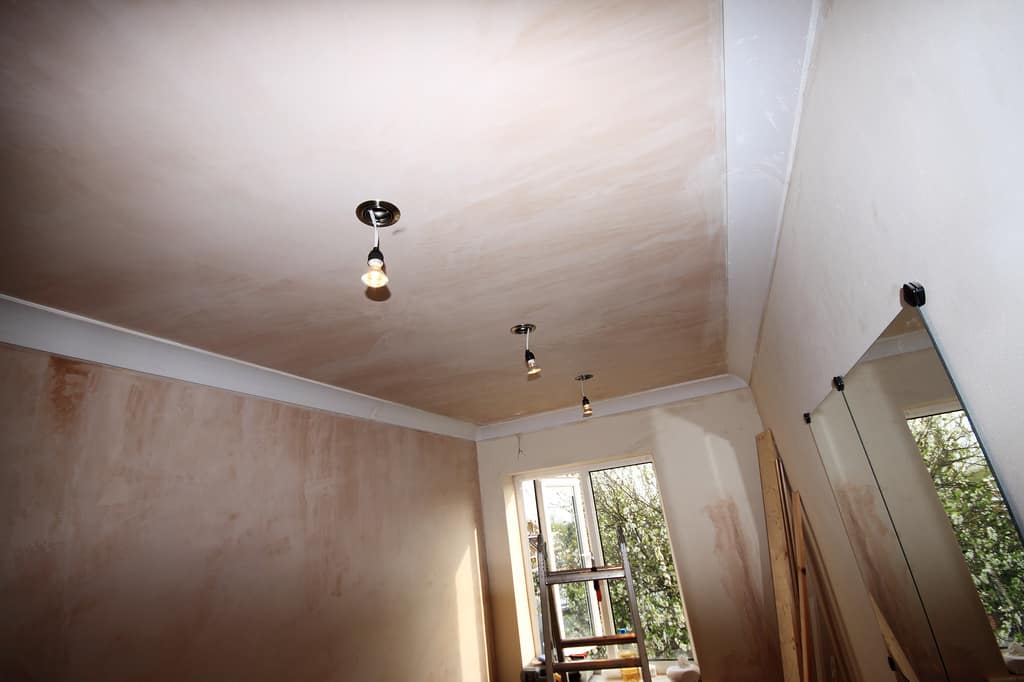Preparing the Bathroom Ceiling: Painting Plaster Ceiling In Bathroom

A well-prepared surface is crucial for a successful paint job, especially in a bathroom, where moisture and humidity can affect paint adhesion and longevity. Proper preparation ensures a smooth, even finish and helps the paint last longer.
Cleaning the Ceiling
Cleaning the ceiling removes dust, dirt, cobwebs, and mildew, which can interfere with paint adhesion and cause the paint to peel or crack.
- Start by removing any loose debris, cobwebs, or other visible contaminants with a vacuum cleaner or a soft brush.
- For mildew, use a solution of water and bleach (1:10 ratio) in a spray bottle. Apply the solution to the affected areas, let it sit for 10-15 minutes, then scrub with a soft brush. Rinse thoroughly with clean water and allow the ceiling to dry completely before proceeding.
- For stubborn stains, consider using a mildew-removing product specifically designed for bathroom surfaces. Follow the manufacturer’s instructions carefully.
Patching Cracks and Holes
Cracks and holes in the plaster ceiling need to be patched before painting to create a smooth surface.
- Use a patching compound or spackling paste to fill the cracks and holes. Apply the compound with a putty knife, ensuring it is pressed firmly into the cracks and holes and smooth with the surrounding surface.
- Allow the patching compound to dry completely according to the manufacturer’s instructions. This may take several hours or even overnight, depending on the compound and the thickness of the application.
- Once dry, sand the patched areas with fine-grit sandpaper to create a smooth, even surface that blends seamlessly with the surrounding plaster.
Sanding the Ceiling, Painting plaster ceiling in bathroom
Sanding the ceiling helps create a smooth, even surface for painting.
- Start with a coarse-grit sandpaper (80-100 grit) to remove any bumps, ridges, or imperfections. Work in small sections, using light pressure and long, even strokes. Be careful not to sand too aggressively, as this can damage the plaster.
- After sanding with the coarse-grit sandpaper, switch to a fine-grit sandpaper (120-150 grit) to smooth out any remaining imperfections and prepare the ceiling for painting. Again, work in small sections, using light pressure and long, even strokes.
- Vacuum the ceiling thoroughly to remove any dust or debris created during sanding. This will ensure a clean surface for painting.
Painting Techniques
/PaintingPopcornCeiling-de586720c664484ba51e4cf364c45500.jpg)
Painting a plaster ceiling in a bathroom requires careful preparation and application techniques to ensure a smooth, durable finish. This section provides a step-by-step guide for painting a plaster ceiling in a bathroom, including proper application techniques and safety precautions.
Using a Roller and Brush
Using a roller and brush for different areas of the ceiling is crucial for achieving a professional finish. The roller is ideal for covering large areas quickly and evenly, while the brush is best for reaching corners, edges, and hard-to-reach areas.
- Roller: Use a high-quality roller with a nap length appropriate for the texture of the plaster. A longer nap roller is suitable for rougher surfaces, while a shorter nap roller is better for smoother surfaces.
- Brush: Use a high-quality angled brush for cutting in around the edges of the ceiling and for painting detailed areas.
Applying Multiple Coats of Paint
Applying multiple coats of paint is essential for achieving optimal coverage and durability. The first coat acts as a primer, helping the paint adhere to the surface. Subsequent coats build up the color and provide a more even finish.
- First Coat: Apply a thin, even coat of paint to the entire ceiling, ensuring that all areas are covered. Allow the paint to dry completely before applying the next coat.
- Second Coat: Apply a second coat of paint, ensuring that the previous coat is completely dry. This coat will provide a more even finish and enhance the color.
- Third Coat (Optional): If necessary, apply a third coat of paint for maximum coverage and durability. This is especially important in areas with high moisture levels, such as bathrooms.
Proper Painting Techniques
- Cutting In: Before rolling the paint, use an angled brush to “cut in” around the edges of the ceiling, along the walls, and around any fixtures. This creates a clean line and prevents paint from dripping onto the walls.
- Rolling: Use a roller with a long, even stroke, overlapping each stroke by about 50%. Avoid rolling too heavily, as this can cause paint to drip.
- Corners and Edges: Use a brush to paint the corners and edges of the ceiling, ensuring that the paint is evenly applied.
- Fixtures: Carefully mask off any fixtures, such as light fixtures, before painting. This prevents paint from getting on the fixtures and ensures a clean finish.
Painting plaster ceiling in bathroom – Painting a plaster ceiling in a bathroom requires careful consideration, as moisture can be a significant issue. To ensure a durable and long-lasting finish, opting for a specialized paint like dulux waterproof bathroom paint is crucial. This type of paint offers excellent resistance to moisture and mildew, protecting your ceiling from damage and maintaining a fresh, clean look for years to come.
Painting a plaster ceiling in your bathroom can be a great way to refresh the space, but choosing the right paint color is crucial. Kilz offers a wide range of bathroom paint colors designed to withstand moisture and humidity, making them ideal for this application.
Kilz bathroom paint colors can range from crisp whites to calming blues, so you can find the perfect shade to complement your bathroom’s décor. Once you’ve selected your paint, remember to properly prepare the plaster ceiling by cleaning and patching any imperfections for a smooth and long-lasting finish.